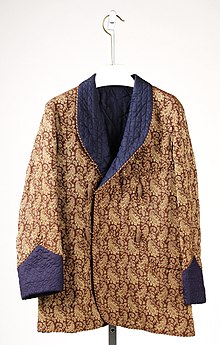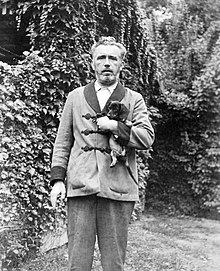Smoking jacket

A smoking jacket is an informal men's style of lounge jacket originally intended for tobacco smoking, designed in the 1850s. A classic-styled smoking jacket comes in a shawl collar, turn-up cuffs, toggle or button fastenings, or simply be closed with a tie belt. It is usually made from velvet, silk, or both.
Originating in the 1850s, The Gentleman's Magazine of London, England, defined the smoking jacket as a "kind of short robe de chambre [i.e. a banyan], of velvet, cashmere, plush, merino or printed flannel, lined with bright colours, ornamented with brandebourgs [i.e. frogs], olives or large buttons."[1]
The smoking jacket evolved out of the dinner jacket, essentially as a dress coat without tails, following an example set by the Prince of Wales (later King Edward VII) in 1865. It has existed in this form ever since and is most commonly worn when smoking pipes and cigars.
Etymology[]
The smoking jacket had its name after its associated tobacco activity.
As a false friend, the name carried on to its derivation the dinner jacket in several non-English languages. In Bulgarian, Catalan, Czech, Danish, Dutch, Estonian, French, German, Greek, Hebrew, Hungarian, Icelandic, Italian, Lithuanian, Polish, Portuguese, Romanian, Russian, Spanish, Swedish, Turkish, and other European languages, the term smoking indicates a dinner jacket, that is a tuxedo.
History[]

In the 17th century, goods began flowing into Europe from Asia and the Americas, bringing in spices, tobacco, coffee, and silks. It became fashionable to be depicted in one's portrait wearing a silk robe de chambre, or dressing gown. One of the earliest mentions of this garment comes from Samuel Pepys, who desired to be depicted in his portrait in a silk gown but could not afford one, so he rented one:
Thence home and eat one mouthful, and so to Hale's and there sat until almost quite dark upon working my gowne, which I hired to be drawn (in) it—an Indian gown, and I do see all the reason to expect a most excellent picture of it. —Diary, 30 March 1666[2]
In the 18th century, gentlemen often referred to a specific style of "night gown" called the banyan, a knee-length robe, a more comfortable in design than the justaucorps, onto which shawl collars became recurrent.
19th century[]

The short smoking jacket soon evolved from these silk garments. When the Crimean War during the 1850s popularised Turkish tobacco in Britain, smoking gained in popularity. After dinner, a gentleman might put on a smoking jacket and retreat to a smoking room. The jacket was intended to absorb the smoke from his cigar or pipe and protect his clothing from falling ash.[1]
20th century[]

The smoking jacket remained a popular accessory into the 20th century. An editorial in The Washington Post in 1902 gave the opinion that the smoking jacket was "synonymous with comfort",[3] while a Pennsylvania newspaper opined in 1908 that it would be "putting it mildly to say that a new House Coat or Smoking Jacket will give any man reason for elation".[4] Famous wearers included Fred Astaire (who was buried in a smoking jacket), Cary Grant, Dean Martin, Jon Pertwee and Frank Sinatra.[1]
While smoking jackets declined in popularity from the 1950s, a minority of wearers still persisted; Playboy mogul Hugh Hefner (1926–2017) was a notable example. In its January/February 1999 issue, Cigar Aficionado stated that it was time the smoking jacket be brought back, perhaps as an "alternative type of formalwear".[2]
See also[]
- Smoking cap
- Dressing gown
- Banyan (clothing)
- Bathrobe
- Black tie
- Tobacco
References[]
- ^ a b c McCormack, Derek (December 18, 2007). "Consider the smoking jacket". Edmonton Journal. Archived from the original on October 6, 2011. Retrieved 2009-02-12.
- ^ a b Boyer, G. Bruce (January–February 1999). "Where there's smoke..." Cigar Aficionado. Archived from the original on 2009-02-06. Retrieved 2009-02-12.
- ^ "The Joy of Slippers". The Washington Post. August 2, 1908. Retrieved 2009-02-12.
- ^ "House Coats and Bath Robes". Oil City Derrick. 7 December 1908.
External links[]
| Wikimedia Commons has media related to Smoking jackets. |
- 1850s fashion
- 19th-century fashion
- 20th-century fashion
- Lounge jackets
- History of clothing (Western fashion)
- History of fashion
- Tobacciana
- Smoking